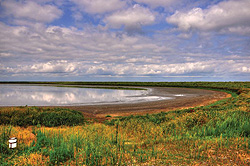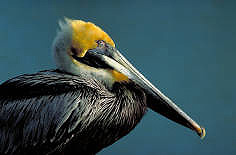The Power of Partnerships: Habitat Restoration in the Chesapeake Bay
By Ross Geredien
Last November, I accompanied U.S. Fish and Wildlife Service (FWS) biologists to inspect a unique habitat restoration project led by the FWS Chesapeake Bay office. Here’s my account of that day:
The wind stings my face as we skim across the water. To my left, the bay’s silvery sheen meets leaden clouds at the southern horizon. I look to my right and see a northern gannett, a large, oceanic bird, floating on the surface.
I’m on a U.S. Fish and Wildlife Service workboat, heading across Chesapeake Bay at 24 knots. It’s a brisk morning, and our destination is Poplar Island, where the U.S. Army Corps of Engineers deposits the dredge spoil from Baltimore Harbor’s approach channels.
Poplar once boasted a lively fishing community, complete with weekend retreats and abundant wildlife. From 1840 to 1990, erosion reduced the island to just 10 acres. Since 1998, however, spoil deposits have restored Poplar to over 1,100 acres of productive marshland, and wildlife is once again flourishing.
Upon reaching the island, some 90 brown pelicans perch nearby. “It’s unusual to see this many,” says Chris Guy, one of the biologists. “Especially this late in the season,” responds Pete McGowan, another biologist. We discuss how recent storms have blown them off-course. They have found refuge at Poplar.
Over 200 bird species use Poplar Island during the year. As we explore the island, thousands of geese and ducks congregate on large, artificial ponds called cells. We also see uncommon species: night-herons, dowitchers, swans, and loons. The abundant waterfowl attract predators like birds of prey. Indeed, in the afternoon a rare short-eared owl flushes from the grass. “First of the season!” shouts Chris.
What makes all this possible? Poplar Island is a partnership among federal and state agencies. The Corps of

Aerial view of Poplar Island in the Chesapeake Bay (Photo provided by U.S. Fish and Wildlife Service)
Engineers manages the dredge spoil operation under the Clean Water Act. The Maryland Environmental Service monitors water quality and nutrients while the Fish and Wildlife Service supervises the restoration. The University of Maryland also investigates a variety of ecological questions here. As a fellow working in the EPA’s wetlands program and a former biologist with the Maryland Wildlife Service, this intersection of wildlife, Chesapeake Bay, and clean water issues naturally resonates with me.
The weather has turned fair as we depart, wind-blown spray glistening in the sunlight. I leave Poplar with a new appreciation of the Chesapeake Bay ecosystem and the efforts to restore its habitat.
About the author: Ross Geredien is a fellow with the Oak Ridge Institute for Science and Education serving in the EPA’s Office of Water, where he works on wetlands permitting issues. Previously, Ross was a wildlife biologist for the Maryland Dept. of Natural Resources where he mapped the state’s rare, threatened and endangered species.
Editor's Note: The opinions expressed in Greenversations are those of the author. They do not reflect EPA policy, endorsement, or action, and EPA does not verify the accuracy or science of the contents of the blog.


I would love to join you on a future visit! Im at EPA in OSWER.
Nick, there are actually organized field trips to the island during the summer months with the Maryland Ornithological Society. I can put you in touch if you’re interested.